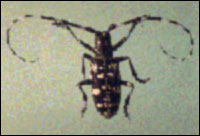
The Asian longhorn beetle was introduced in the United States from Asia. The first infestations were detected in Brooklyn and Amityville, New York in 1996. It is believed the beetle arrived from China and Korea in solid wood packing materials such as pallets and crates. While the beetle has some natural enemies in Asia, it has no natural enemies in the United States, making it a great threat to the nation's trees.
The beetle attacks hardwood trees such as Norway, sugar, silver and red maple, horse chestnut, poplar, willow, elm, mulberry, and black locust. Adult female beetles lay their eggs in openings in the bark. The larvae then bore tunnels into the tree, disrupting the vascular system, which carries water and nutrients throughout the tree. The larvae spend fall, winter and spring inside the tree, and then bore out of the tree as adults in the summer. This tunneling can eventually weaken and kill the tree.

Signs of Infestation
The tunnels left behind are approximately 3 1/2 inches in diameter or larger with sap flowing out of the entry holes in the bark. The beetles also leave behind waste and sawdust at the base of a tree and in branch crotches. Yellowing leaves and leaf drop out of season are additional signs of the insect's presence.
Identification
Adult beetles are up to 1 1/2 inches long with antennae 1 1/2 to 2 1/2 times their body length. They are shiny black with white spots. Their antennae are also black with distinctive white stripes. Their plate-shaped feet are black with a whitish-blue upper surface. (Photo by, R. Duncan, Canadian Forest Service.)
Information taken from the USDA Animal and Plant Health Inspection Service site and the Wisconsin Department of Agriculture, Trade and Consumer Protection Agency site.